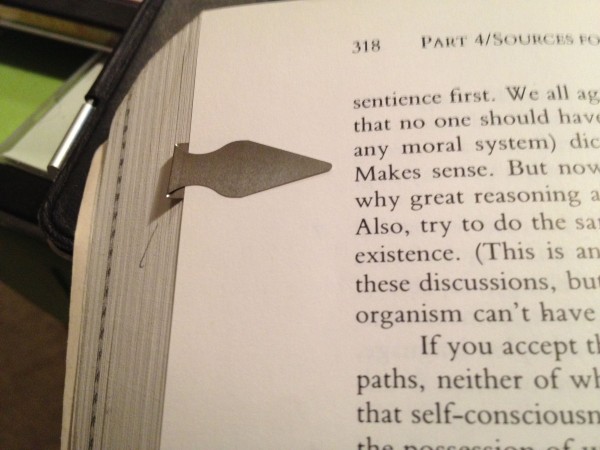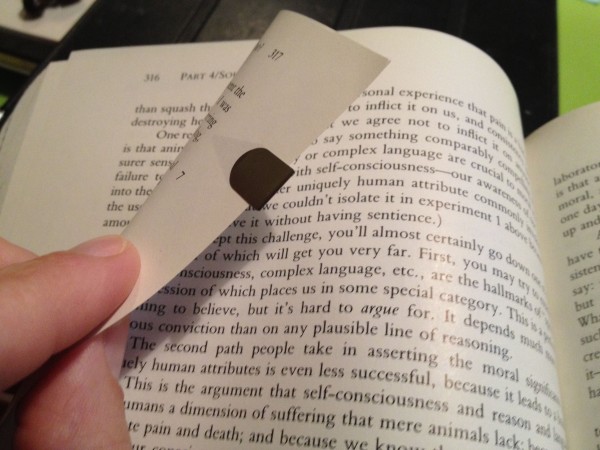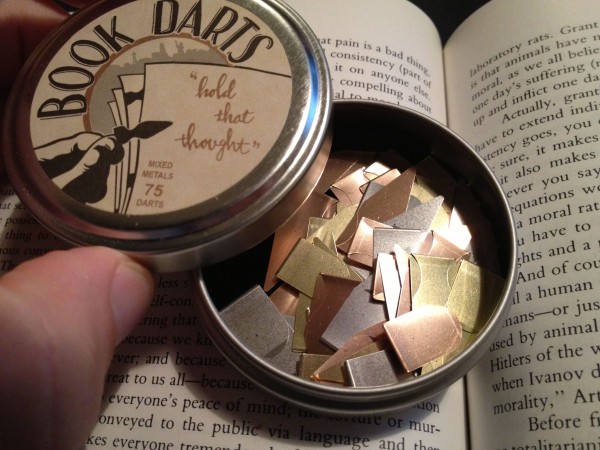Tricks for writing: book darts
For years I was a notorious page corner folder. I’d mark corners of passages I needed for research with a fold, making bibliophiles cringe and scream. I thought books should look used: it’s a sign of love that a book traveled, got scuffed up, filled with post-it notes or coffee stains. I love when readers post photos of my books that have lived good lives.
But then, I love books and want them to last. It’s really not nice to mark up books that aren’t yours (but are owned by friends or libraries). If I had a better way I’d have used it, I just didn’t know of one. So when I showed my brother-in-law a particular good book (with my folds on every other page) his eyes lit up. That Christmas I was gifted a set of book darts.


Book darts are small arrow shaped strips of metal that you can place on pages to mark a passage. They are easy to use, easy to remove, and do zero damage to books. It’s a great paper clip-esque design: minimal and clever.

I use these things so much in my research that I own several hundred of them (I’m faster at marking pages than I am at reviewing the marks later).
They’re sold in various quantities at bookdarts.com and some bookstores sell them too. If you are student or writer and spend your days making notes in books, I highly recommend them.

I do the same thing with those little sticky tabs:
http://www.3m.com/us/office/postit/products/prod_notes_pn.html
Wherever there is something I want to keep track of I slap one right next to the relevant text. They’re really easy to take off when no longer needed, and I haven’t noticed any leftover stickyness.
Plus you can get a few hundred for a couple bucks.
I tried those, but they had two downsides:
1) They’re hard to reuse. Maybe 2 or 3 uses before they lose stickyness.
2) It’s noisy to pull them out, especially at night with my wife sleeping a few feet away (I often read in bed).
I too used book marks extensively all through university and find them extremely useful for technical reading as well (since I often have three or four books I’m swapping between).
In a fit of organizational anal-retentiveness I took the time to demark numbers on all of my book darts about 00 – 248 or so.
I could then easily associate this bizarre and non-sequitur note in my folio with the passage in the text by number. This was especially useful when I would be hopping from text to text and my memory would remember the passage but not which book it was in etc.
The Sony Portable Reader sounds like the device to solve bibliophile woes.
Very very useful. I’ve been using these little things for a year now and I am very content.
Nifty! Even the best “removable” adhesive will leave some kind of residue on your books which will eventually react chemically with the paper, so a product like this is definitely a godsend from a library preservation point of view. I work in a Reading Room of a large academic library, and sometimes researchers will put hundreds of Post-Its in a book — not just newer books that probably won’t last much longer than the cut-rate glue in their Permabindings but books that are 100-200 years old! I want to tell them that sticky notes make the baby Melville Dewey cry. Maybe now that I’m in charge of supplies here I’ll requisition a box or two and see if I can’t convert some of our patrons.
Thanks for the post!
Readers of the Berkun Blog, may, if they wish to, buy our Book Darts for the wholesale costs. Order on the reseller side of our site or alert us in the comments box when you order, and we’ll make the adjustment.
http://www.bookdarts.com
In developing this archival quality menas of marking and re-finding reading discoveries, we hoped to encourage readers to share what they find.
(Our friend, Brother Blue, a Cambridge storyteller, said, “We never know which two people might become critical mass and transform the future.”)
Bob, unfortunately I couldn’t even find out where to order your wonderful book darts. I went to bookdars.com, clicked every link, and skimed every page, but just couldn’t find anything remotely related to order form. Yes, there was link “your personal cart”, but you know what? When I clicked on that, I saw only a page saying that my cart was empty. I guess we could imagine how many prospecitive customers were lost. Please please, even if you don’t have resource to polish the design of your site, at least add a big shinning “Order Here!” link in your navigation frame!
Danny: Just go the productfirst, buy it, and in the purchase form mention Bob’s offer.
Thaks, Scott! My fault. I saw the product name “Tin”, and immediately assumed it was a tin jar, so I left the page promptly.
These book darts are great, especially for someone like me who does not, will not, can not, mark in or (shudder) dog ear pages in books. That doesn’t mean I don’t use my books, for me its a matter of respect for the printed page.
When I was first married I had to train my wife to not dog-ear corners. I must have been persuasive, shes now more adamant about it than I am.
i go both ways on this: I hate the idea of worshiping books as pristine things locked up in cabinets, kept safe from stains and marks, and, well, life.
As an author I get jazzed when I see a copy of my book that has lived: that has traveled, been in people’s briefcases, kitchens, coffeeshops, marked up with comments, dog-ears, tabs of tape to mark sections, or pizza stains from late night whateve-ring. That’s how I know I wrote something good: that the book has lived with person who bought it. There’s nothing sadder to this writer than a mint condition book on a shelf.
But on the other side I do think of books as sacred – the making of them and what they can mean to people – especially other people’s books. So I do treat library books with great care and protect them.
Anyway, I do use darts all the time, unless it’s my copy of a book and I don’t have any with me.
I posted about book darts in my blog. It’s written both in Korean and English. It’s really a nice tool, isn’t it!
Post-its and sticky tabs: if you leave them in a book long enough they develop enough of a grip on th e paper to tear it when they are finally removed (especially if it’s an old book).
The long-term effect of the adhesive on paper hasn’t been discovered yet, but it certainly leaves marks on leather bindings.
Trust me, I’m a rare-books librarian ;) (struggling novelist in my other life)